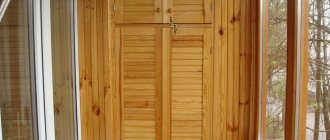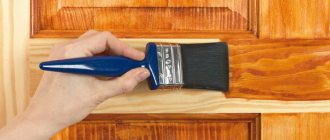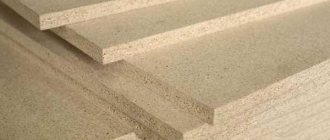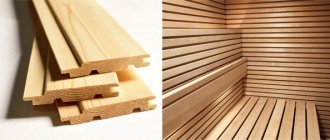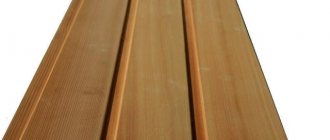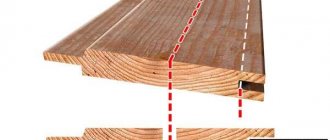Wooden lining is a beautiful, natural material. It is not surprising that so many users around the world prefer it as a finishing and facing material.
The environmental friendliness and natural beauty of wood not only decorates the room, but also creates a certain microclimate in it. And the lining covered with a thick coating (paint, varnish) allows you to create any decor.
But wood has a significant disadvantage that affects the performance characteristics of the lining - it is subject to rotting, various damage, and also tends to darken.
This article is intended for those who want to protect and at the same time preserve the lining in its natural form. Let's consider step by step how and what is the best way to coat (impregnate, treat, paint) wooden lining (euro lining).
I must say that the “take a brush, paint and paint” method is good precisely because of its simplicity. But how long will wood painted this way last? Wouldn't it be better to take a more thorough and correct approach?
Proper painting of wooden lining consists of 4 stages:
Types and features of lining
Nowadays, lining is often used for interior work. But decorating the space is done with different types of materials. They are:
- Quarter paneling. Each element is equipped with protrusions on the sides, which allows them to be overlapped.
- Simple. It is characterized by the presence of tongue-and-groove fastenings.
- With tongue and groove. The material is intended for mounting on walls and ceilings. It looks like a regular tongue and groove board, only smaller in size. The material is intended primarily for office premises.
- Eurolining. It resembles an edged board. On each side the fragments are processed with high quality. The tongue-and-groove system is used for connection. In the production of such lining, coniferous wood is used. Fungus or mold does not grow on this material, since there is a sample on the back of it that provides air removal.
- "American". This type of lining is characterized by an irregular rectangular shape. There is a groove in the widest part of the fragment, thanks to which you can achieve the effect of laying the parts overlapping.
- “Finka.” All elements have an oval shape.
- Block house. With its help, you can create an imitation of a rounded log from inside the room. To fasten the lining, sheathing is required. The material improves the heat and sound insulation of rooms.
You can use lining in a bathhouse, sauna, living rooms, and in the country. But if you are already tired of the natural color, then you can choose different paint options for decorating the surface. There are also substances that help protect wood and increase its service life.
Ideas
In a modern interior it is very difficult to find a place for classic lining with a light fiber texture. Most often it will look like a tree trunk torn out of the forest and brought straight into the house. You need to choose a finishing method and create the desired decorative effect so that the interior looks as harmonious as possible (read more about where lining is used and how to sheathe walls inside and outside with it, and find out how to beautifully sheathe walls and ceilings with wooden boards in a separate material).
There are several interesting ideas for painting wooden panels:
- Alternate combination of different tones of coloring compositions, panels of various thicknesses and widths.
- Multi-profile panels can be combined into an interesting relief.
- The placement of spotlights in different areas of the cladding creates incredible lighting effects that significantly transform the appearance of the lining.
- The use of several colors of paints or varnishes in the same color range, but different in saturation and tone. This will allow you to emphasize some areas and zoning the space.
- Painting on a wooden surface looks very original and natural.
- Bleached canvases create a feeling of spaciousness and a more noble interior.
Important
It is important not to overdo it and not turn the room into a color blot. It is necessary to adhere to a harmonious combination of colors and their saturation.
How is coloring done?
How to paint lining so that the effect is long and impressive? For such an event you will need a set of tools:
- Set of brushes and roller. If possible, then a spray gun.
- Tray. To make it easier to pick up paint.
- Protective and decorative compounds.
- Sandpaper, stiff brush.
- It is better to have a stable stepladder and glasses to protect your eyes.
Using a spray gun allows you to quickly complete the work of painting the lining.
Painting consists of several stages. It is much more difficult when work is carried out on an old coating. Then it becomes necessary to remove the old decorative layer and clean the surface well.
Stage one - preparation
Purchased products are checked for possible damage and deformation. It often happens that materials are purchased that belong to a lower class. They require a long preparation - they are processed with sandpaper, and the cracks are covered with wood putty. If there are dark spots on the surface, then bleaching is performed.
If the material has defects in the form of cracks, they are eliminated using putty
Stage two - primer
It is necessary to cover the front side of the lining with priming compounds. This will reduce the consumption of other solutions, increase adhesion, and will also prevent the elements from being subject to deformation
In this case, special attention is paid to the knots; they are literally impregnated to eliminate the possibility of falling out if drying occurs
The primer improves adhesion when painting lining
Stage three - impregnation
Now protective impregnations are applied. These are fire retardants and antiseptics. Impregnation is carried out over the entire surface. Do not allow unpainted areas to remain
It is important to consider that such products should not have any foreign (pungent) odors or change the color of the wood.
When applying protective impregnation, it is necessary to ensure that no untreated areas are left.
Stage four - coloring
How to paint lining inside a house? This procedure begins only after the material has dried well from previous manipulations. The process is:
- The paint is prepared in advance. The solution must be well placed, because at the bottom there may be sediment, which includes the main components.
- A small part of the composition is poured into the tray if a roller is used. It is better to provide a container for the brush that is easy to carry. Using a spray gun makes the work better, and the paint is poured into a special container.
- It should be taken into account that movements are performed along the fibers of the material. You can’t stay in one place, the coating should be uniform.
- Several layers are applied, this will provide an excellent decorative effect.
To obtain a good decorative effect, the paint should be applied in several layers.
Still, how to cover the lining? This question is quite complex, the answer to it depends on many factors that are calculated purely individually. But it must be taken into account that if the composition is used over large areas, then it must ensure the “breathing” of the material.
What may be useful in the process
You will need the following tools:
To paint lining, you will need tools such as: roller, brushes, safety glasses, tape, paint, and so on.
- gloves;
- step ladder;
- bucket;
- sandpaper with fine or medium grain;
- spray gun (if possible);
- brushes of the required width;
- clothes for work that you don’t mind throwing away;
- means for removing old paint (if required);
- metal brush;
- tray (for ease of painting);
- primer;
- wood bleach (if necessary);
- paint, enamel, varnish - depending on what you chose;
- impregnation.
Preparing for painting
Before covering the lining with varnish or acrylic, it should be cleaned of dirt and degreased with an alkali-based solution, and then sanded with a flat pumice stone or a grinding wheel. This will require the following tools:
- sponge and brush to remove dirt from the surface;
- roller, brush or spray for applying restoring and brightening agents.
This operation leads to the loss of all the protective characteristics of the wood. To restore them, treatment with a disinfectant composition is necessary. It will not only protect the wood, but also improve the quality of the varnish coating.
How to paint lining correctly
Using regular oil paint to renew the surface gives it an artificial shine and hides the natural grain of the wood. In addition, such coating is short-lived and will soon require modernization. When using acrylic varnish on wood panels:
- the original pattern is preserved;
- ensures attractive appearance;
- creates lasting protection from moisture and weather changes;
- the service life of the cladding is extended (up to 8-10 years).
Depending on the degree of darkening, you can use the concentration of the solution as prepared or dilute it with water in a 1:1 ratio. To avoid differences in the tone of the coating, it is necessary to apply a test stroke in an inconspicuous place. After this, the paint color is selected.
The recovery procedure consists of step-by-step operations:
- surface cleaning;
- drying wood;
- antiseptic treatment;
- testing and selection of shade;
- applying acrylic paint.
The final finishing with clapboard is quite often used in the repair of balconies and cottages. In order for the cladding to maintain a beautiful natural appearance for a long time, you need to follow the rules for using wood material and know how to lighten it. To ensure high-quality restoration of darkened panels, you should choose the right bleaching method. For this purpose, it is advisable to consult with specialists or read the instructions.
Reasons why you need to paint the lining
Lining diagram.
- Lining is sheets of wood, and wood is a flammable material. Of course, no coating will provide 100% fire protection, but there are special protective compounds (fire retardants) that significantly increase the material’s fire protection.
- All natural materials begin to rot over time. This is a natural process. But it can also be stopped if it is coated with a special compound. These are antiseptics. The lining does not need to be painted, but it must be coated with an antiseptic.
- A special coating serves as protection against mechanical damage, scratches and cracks. Located in a durable layer on the wood, it takes the entire blow and at the same time prevents cracks from forming.
- In the sun, the tree does not lighten; on the contrary, it darkens. Therefore, protective coatings protect against exposure to the sun's rays, thereby preserving the natural color of the wood.
- Aesthetic appeal. With the help of colorless varnishes, you can give the wood only shine or tint it a little. There are also paints that completely hide the original color underneath, preserving only the structure of the wood.
How to properly paint the inside of the lining: technology
To paint lining in “dry” rooms inside the house, you can use any type of paint. Here you simply decide on the requirements for the decorative appearance of the surface. If the lining is dry, it can not be impregnated with protective compounds, or you can choose paint/varnish/wax with appropriate additives. You can paint it only on one side, leaving the back side untreated.
Paint each panel of the lining separately
If the lining will be used in damp or unheated rooms, on a balcony, it must first be thoroughly impregnated with protective compounds on all sides, maybe twice. Only after the impregnation has dried can it be painted, varnished, or, in general, given decorative properties. Another point: when installing the lining on a wall or ceiling, it has to be cut into pieces. Places of cuts in damp rooms must also be coated with the composition. It is not necessary to wait until it dries, but it is necessary to process it.
There is one very important nuance that many amateur decorators overlook. If you want to get a professional-level painting of the lining, you need to process each board separately: sand, paint, dry, and only then assemble the surface from the already painted lining. That is, mount already fully processed boards on the wall or ceiling. Only with this approach will the surface of the lining have the same color from any point.
It’s difficult to paint the entire surface of a clapboard wall well
If you paint an already assembled surface, unpainted areas remain in the grooves and recesses, making it difficult to sand large areas. You definitely won't get a perfectly flat surface. The quality of finishing in this option is not above average. It is permissible to paint a finished surface if you are renewing the paint job. This must be done at different intervals, depending on the operating conditions and the properties of the paintwork material.
Correctly, the painting technology looks like this.
- The lining is checked and sorted. All bent, bent or cracked boards are rejected. They can be used to test color, select color, number of layers, practice technique and painting sequence.
- Boards that have been sorted are sanded until completely smooth. It is most effective to work with a sanding machine, but you can also use a block with sandpaper attached to the surface. Sandpaper grit - 250-280. When grinding, circular movements pass through the face, tenon and groove. The back part of the lining can be left without treatment. It is more convenient to work with a grinding machine
- Apply the composition with a roller or brush. Each type of coating has its own points and features - they are written on the can or in the accompanying instructions. In general, the rules are simple: take a little paint and apply it in single strokes along the entire length of the lining. Then rub thoroughly and shade until a uniform color is obtained.
- Having achieved uniform coloring, leave to dry.
- After drying, sand again if necessary. This step is often necessary when working with opaque paints and varnishes. The first layer of paintwork raises the pile of the wood, which is why it becomes rough in places. This pile is removed by repeated sanding.
- The second layer of paintwork is applied. Drying.
There can be many layers: it depends on the hiding power of the paint and on what effect you want to get. But in any case, one rule remains: there should be little composition on the brush. The exception is impregnation or primer. They are applied with a well-moistened brush, but only those without pigment. When applying pigmented protective compositions, the rules for paints apply - the minimum required amount of the composition is well shaded.
Sometimes, even with careful rubbing of the paint, stains are clearly visible. This is not a bad paint, but the properties of wood: in some places the pores absorb better, in others worse. In order to achieve an even color in this case, the surface is first primed. You can use any wood primer or colorless matte varnish (can be water-based). After drying, the surface is sanded (yep, again) and then the required number of layers of paint are applied. Only in this case, after the first layer of paintwork, grinding is rarely required, and if necessary, then in some places, more often on a tenon or groove.
Watch the video to see how to evenly apply glaze, oil or wax.
If furniture quality painting is required, there are even more layers: first a stain is applied, then two layers of primer. After drying, the surface is sanded until the surface is completely matte, first with grain 280, then 320, after removing the dust, a finishing layer is applied - varnish. An example of such work is in the video.
Carrying out the procedure
To paint wooden panels, paint or varnish with colors and dyes of different types and compositions is used (how to properly varnish a panel for a long time?). Application techniques and finishing methods depend on the composition of the paintwork material.
Varnish
To paint wooden panels with varnish you will need:
- check all existing lining, sort it by color and quality, exclude panels that contain falling knots or other obvious defects;
- thorough sanding is carried out until absolutely smooth to the touch is achieved;
- if necessary, cover with a special primer or apply the first base layer of varnish, leave each canvas to dry without touching the treated surface;
- if an opaque varnish is used, then repeated sanding over the painted layer is necessary;
- A second layer of varnish is applied until the color is uniform over the entire area of the canvas, and then dried.
Advice
Rejected panels can be used as test panels. On them you can see the type of coating with different numbers of layers, etc.
You can watch how to properly varnish the lining, what tools and techniques to use for this, in the following video:
Dyeing white
To create the desired decorative effect, several coloring techniques are available:
- Acrylic pigment primer diluted to 80-100% is applied like a regular varnish. It creates a coating with a long service life, but its price is high.
- Polyurethane pigment primer labeled “bleached” or “white” with a dilution of up to 80-100% also provides the desired decorative effect, but over time the color becomes yellow.
- Oil with wax - with a single-layer coating requires rubbing with a rag to preserve the wood texture; with a two-layer finish the surface is opaque.
- Tinting or staining - often found with the markings “bleached oak”, “frost” and the like. The peculiarity of the finishing is a multi-layer coating with very thin and uniform films. Otherwise, a peeling effect will form on the surface.
These methods provide different shades of white, depending most on the type of wood.
You can learn how to quickly and correctly paint the lining white from this video:
Technicians
For high-quality painting of lamellas, the following rules must be followed:
- Dry lining is processed only from the outside, and a wet panel must either be pre-dried or processed on all sides, including the ends. This is especially true for rooms with high humidity.
- The coating is applied to each plank separately to achieve an even color over the entire surface and to prevent the appearance of visible boundaries between strokes.
- When painting lining that is already installed on the wall, it is difficult to achieve maximum filling of the joints, so you need to choose a special brush.
- It is necessary to adhere to the technology recommended by experts for painting tongue-and-groove wooden lamellas.
Attention
If the quality of the first layer remains below average, then it needs to be sanded and primed again. Apply paint only to dry boards.
This approach will even out the density across the entire surface of the material to ensure a uniform shade.
Often they cover surfaces that are already installed on the wall. Therefore, the technology may differ slightly. You need to paint along the board, but with movement from one edge, for example, from one doorway to another. This will provide more even coverage as there will be no wet transitions.
Secrets of decorative wood staining: techniques and tricks
City dwellers want to preserve the natural color of wood as much as possible. For those for whom wood in the house is a boring everyday thing, paint the interior lining in some unusual color. Modern paintwork materials allow you to achieve different effects. For example, textured or brushed lining, but in two colors. This technique is often used in loft style interiors.
Brushed lining in two colors is an excellent choice for decorating walls
The trick is to apply two layers of different colors. The first layer is a dark color, the second is a light or brighter color. After playing with colors and the order of their application, you can create your own version. Watch the video - how to get lining brushed in two colors.
Painting in two colors may not be the same. You can make the recesses a darker color, and only slightly tint the face (front part) or do everything exactly the opposite. The result is a striped wall made of clapboard - the effect of a slatted wall.
Tips for choosing a finishing coating for wooden lining
- color . Since stain or paint changes the color or shade of the lining, you need to use this property. For example, light shades visually increase the space. The use of different colors/shades allows you to zone the room;
- compound . The prefix “bio” after the name of the varnish indicates the absence of harmful substances. This composition can be used for interior work;
- manufacturer . Many domestic analogues of lining varnish or paint can create worthy competition for foreign goods. At the same time, the price of the product will be more humane.
How and with what to paint the lining in the bathhouse and steam room
Wax composition Evrotex-Sauna for lining in a bathhouse Due to the high temperature, it is better not to paint the lining in a bathhouse, but to treat it with protective compounds.
An excellent solution would be to use wax compounds, for example, Evrotex-Sauna. This coating is suitable for use in conditions of high temperature and cyclic intensive humidification.
Advice. You only need to apply the varnish once in the sauna. In the dressing room - you can make several layers.
How and with what to paint the lining on the veranda
The veranda or terrace is exposed to the greatest influence of atmospheric factors, so the material must be resistant. First coat with a layer of primer, and then 2-3 layers of varnish or paint.
How and with what to paint the lining inside/outside the house
There are no particular differences in painting a house outside or inside. The only difference is in the coatings used. Varnish/paint for interior work must meet environmentally friendly requirements. For outdoor work, it is more important that the coating can withstand moisture, temperature changes, and exposure to UV rays. The same type of paint can be used inside and outside a building. The difference is in the number of layers applied.
How to paint lining correctly - tool
To paint the lining you can use:
- brush. They are convenient because they allow you to paint wood in corners and hard-to-reach places. The paint is applied most evenly with a brush;
Advice. To apply the paint with a brush evenly and avoid smudges, you need to immerse the brush halfway in the paint.
- roller Allows you to paint quickly. However, to obtain a uniform layer you need to paint several times;
- spray. Allows you to get the job done as quickly as possible. But it increases paint consumption;
- mitten (chain-shaped). It is convenient to use a glove to paint (impregnate) the places where the lining joins (frames) the pipes;
- foam sponge.
How to properly prepare wood?
Before applying paint and varnish composition to wood, it must be prepared.
Drying the panel
On raw wood, the maximum service life of paint and varnish coatings rarely exceeds 2 years, and more often it is even less than 1 year. Therefore, the lamellas must be kept outdoors or indoors, the humidity of which is more than 15% for up to 30-40 days. It is advisable to avoid direct sunlight, which will lead to uneven drying.
Deep penetration antiseptics significantly speed up drying.
You can check the humidity level like this:
- cut a square of 0.4x0.4 m from polyethylene;
- wrap the panel and secure it tightly with tape;
- maintain in this state for a day in room conditions;
- measure the moisture content of polyethylene from the inside.
An oilcloth that is wet to the touch indicates that the panels have not dried sufficiently.
Processing of lamellas
If materials are category B, then they must be sanded. To do this, use a power tool or regular wood sandpaper. In this case, the last stage should be carried out with finishing fine-grained sandpaper. This is done to level the surface of the lining in the area of knots, various inclusions, and differences.
Tip You can process the wood after attaching it to the wall with a sander or an abrasive nylon brush.
here
Applying primer
The essence of treatment with this composition is the creation of a dense layer on the surface of the wood, which binds dust, eliminates small specks after sanding, and reduces the porosity of the material. Adhesion increases, and paints and varnishes gain stronger adhesion.
An additional advantage will be the fact that after such surface treatment, paint consumption is significantly reduced. Therefore, you can purchase more expensive and high-quality compounds.
The following types of wood primers are used:
- based on epoxy resin;
- based on silicone and acrylic;
- acrylic.
You only need to choose a special composition for interior decoration; for this you need to make sure that the packaging has the appropriate markings.
Choosing a coloring agent
Painting of the lining is carried out using:
- oil paints;
- acrylic paints;
- acrylic aqualacs and alkyd paints and varnishes;
- antiseptic.
The lining can be coated with oil paint, which is suitable for both interior and exterior work.
Paint for lining can be oil-based, as we noted. It absorbs perfectly into the wood. Moisture usually does not pass through it; precipitation is not a problem for oil paint on the street. But the color may fade over time; another drawback is that it takes a long time to dry. Therefore, if the material was covered with dark paint, it will quickly fade.
As for acrylic paint, it also withstands all precipitation well, but its color does not fade over time. In addition, the surface will not lose its ability to pass air. Such paints allow steam to pass through, have elastic properties, and do not crack.
Scuba tanks are usually used inside the dacha. After all, they are environmentally friendly and hypoallergenic. Alkyd varnish is used for painting floors, since the coating material is hard and can withstand heavy loads. True, after ten years, wood coated with such a paint and varnish material will need to be repainted.
Materials for interior painting
When selecting the necessary tool, it is necessary to take into account that before painting the surface must be treated with anti-rot compounds. With this in mind, you should stock up on the following materials:
- Coarse sandpaper to clean the surface from dirt and foreign matter. This is especially necessary for lower grade linings, the technical conditions for which require the presence of resin pockets - if they are not cleaned out, the painting will not be of high quality.
- Set of painting tools. In addition to the traditional flat brush, you also need a wool roller, a bucket, and a spray gun/spray gun. For tall rooms, a stepladder may also be required.
- Safety glasses and a gauze bandage - if it is impossible to work in a well-ventilated area.
- For priming and antiseptic treatment, it is better to have a separate set of painting supplies, since it is not known in advance how dissimilar coatings will interact with each other.
Chemical cleaning
The simplest and most reliable way to remove contaminants is to use liquid chemical compounds. They are evenly applied to the surface to be treated according to the instructions, and after a while they are washed off along with the dirt. Highly concentrated preparations contain alkaline components that promote rapid removal of soot from surfaces without damaging the wood structure.
To quickly clean walls and floors, you can use a mop with a telescopic handle.
No less effective in the fight against soot are chemical sponges impregnated with deep penetration substances. They contribute to the quick and safe removal of the smallest particles of soot and soot that have penetrated the wood structure.
The principle of working with sponges is quite simple: holding the sponge with one hand, clean the surface from top to bottom.
Finally, it is recommended to wash the cleaned surface with clean water and wipe dry with a soft cloth. This is done as follows: the floor is covered with film or oilcloth to protect the surface from further contamination.
Next, clean water is poured into the container, to which a detergent composition, for example, for washing dishes, or any other degreasing agent is added. The soot is washed off with smooth movements using a soft sponge.
Some useful tips
If we are talking about painting the lining inside the house, then it would be useful to read some useful tips that will definitely help during the work.
In order to ensure uniform distribution of color on the surface of the lining, it is necessary to thoroughly mix the paint before work. This can be done using a metal rod or a wooden stick. The main thing is that the material is clean.
In order to be sure that the paint is really chosen correctly, before starting work it is worth making a preliminary touch on the surface. Only after this can the main body of work begin.
The most convenient way to apply paint to the lining is with a brush; this will help paint the surface more evenly.
It is best to paint the lining not with a spray gun or roller, but with an ordinary brush. At the same time, apply paint to the surface evenly.
The primer should be the same color as the paintwork. You can make it this way by adding a bit of paint to it before priming.
If the room is too hot, painting is not recommended. In this case, the paint will dry too quickly. This cannot be allowed. It will not adhere too well to the surface of the wood. When it comes to painting, it is better to create optimal conditions for this process. The room temperature should be between 20 and 25°C.
You need to carefully approach the processing of the ends of the lining. To do this, it is necessary to apply a primer on them in several layers, and also apply a paint coating in several layers.
If there is a lot of paint left on the edges of the can, it needs to be collected using a scraper. If it is not there, then you can use an ordinary sheet of iron folded in half.
The paint must be applied with a brush in several layers. The layers should be thin. It is best if there are three layers on the surface. In this case, the lining will be well saturated with paints and varnishes.
Methods for painting lining
Before choosing a painting method, you need to learn about the rules for performing work, without which it will not be possible to achieve high quality surface finishing. The main point is the timing of the work. The lining is painted no earlier than 3 days after the last rain. During this time, the wood will be able to dry completely.
The air temperature must be positive. The limits recommended by paint manufacturers are +5°С – +20°С. It is also important to consider the time of day. It is best to start coloring at 10-11 am. By this time, the lining will be completely dry from the morning dew.
Types of painting materials
How to paint the lining? Answering this question can be quite difficult. The fact is that there are many compositions that differ in their characteristics. Their correct use can transform the room or, conversely, ruin the entire appearance.
Protective compounds
These solutions act as protectors, but can provide a certain decorative effect.
Fire retardants
It is necessary to coat products with such a composition that are located in places where fire may occur. Of course, it is better to impregnate all wooden materials used in finishing work.
Antiseptics
Substances that eliminate the threat of various types of bacteria that contribute to rotting and destruction. This solution is perfect when you want to leave the material unchanged. The composition will protect the product for a long time, so it will not require additional painting.
Antiseptic protects the lining from various bacteria
Lucky
In fact, varnishes are already closer to paint compositions, but they have a good protective function. Painting the lining inside the house can be done with different materials:
Acrylic lacquer. Great for all interior spaces. It can be transparent or translucent. If necessary, the substances can be tinted.
Synthetic materials
This option requires caution. At dachas they cover the rooms that are located at the entrance to the house.
It is quite easy to work with varnish compositions, you just need to take into account that to achieve a better result you need to apply them in several layers.
Varnish allows you to protect the lining from rotting, damage and destruction
Decorative options
Paint for lining is the best way to transform a surface that has already served for a considerable period of time. That is, if over time the product began to darken, cracks appeared in places. In this case, it is best to apply paint. As a result, you can completely renovate the interior of your country house and bring to life ideas that will help with this.
Painting the lining is one of the best protection options, which also performs a decorative function.
How to cover the lining? It should be taken into account that different types of material can be used for work.
Oil paint
It is considered one of the most popular substances. This option has been used for many decades. This is because the solution has excellent characteristics. They consist in the fact that the composition penetrates deep enough into the upper layers of wood, ensuring its long-term preservation. The coating retains its properties for 7-10 years.
Some disadvantages cannot be excluded:
- The material has a rich chemical smell that takes a very long time to dissipate.
- The first point leads to limiting the dyeing time. That is, it is not possible to work in winter, because thorough ventilation is required, which can defrost the entire country house.
- The protective property of paint is fraught with another drawback - the material firmly clogs the pores of the wood, it stops breathing. This means that the microclimate, which is especially valuable when using lining, will be spoiled.
Therefore, this composition is used extremely rarely for interior work.
Acrylate paint
It should be immediately noted that this type is very similar to acrylic compositions, but has a lower price and the necessary characteristics.
This coloring option has the following properties:
There is no unpleasant odor that requires long-term ventilation. The coating is much more elastic, which increases service life. It more successfully withstands aggressive external environments
This is very important, because many country houses are left without heating during the winter. The surface remains breathable, which allows you to maintain exactly the atmosphere that is inherent in wooden structures. The work is done much faster and easier.
Acrylate paint allows you to create an elastic, breathable coating
Of course, such material costs a little more than oil paint, but the result exceeds all expectations.
Acrylate paint for woodwork
What to process?
There are many types of paints and varnishes for wood on the shelves of construction stores. You need to pay attention to the recommendations of manufacturers of finishing compounds.
The most popular paints:
- Enamel. Easy to apply, forms a durable shiny film on the finishing surface. Suitable for painting lining in country or country houses.
- Glaze. Sold in transparent form, can be painted over with special colors. This coating is pleasant to the touch, beautiful to look at, and reliably protected from moisture.
- Alkyd varnish. Has good resistance to temperature fluctuations and high humidity. But flammable, long-drying.
- Acrylic aqualac. A water-based composition that dries very quickly, creating a stable, reliable coating with excellent decorative characteristics. When finishing, it does not emit unpleasant odors, since it consists of environmentally friendly components.
- Acrylic paint. Provides wood with a coating that protects the material from moisture. The compositions can retain their original shade for a long time, while they are odorless and quickly harden after application.
- Oil paint. This paint and varnish material is rarely used for interior decoration. Despite all the advantages and useful qualities of the coating when processing wood, it emits a sharp, unpleasant odor. Another disadvantage is the long drying period.
- Water-based paint. It is characterized by quick drying, no odor, and easy application. Without hiding the texture of the fibers, the composition gives the material a noble white tint.
Important
When using some types of paint, for example, water-based or aqualac, additional treatment of the wood with oil is required. This will give the material the necessary protective properties against moisture.
A specialist in paint and varnish products explains how to coat wooden lining inside a house:
Choosing paint for painting
In most cases, we are talking about painting internal surfaces, and the type of paint is selected accordingly - acrylic, water-based or oil-based (white).
The advantage of acrylic paints is their environmental friendliness and comparative cheapness. Oil paints dry faster, but at the same time they emit a specific odor that is not always acceptable to others. Water-based paint, for all its non-toxicity, is still inferior to the other two types in terms of coating durability. Therefore, the use of a certain type of paint is determined by the specific conditions of its use.
Recently, scuba paints have been actively used for painting linings, previously used mainly for painting ceilings. The advantage of scuba tanks is that, while forming the color of the surface, they also form a dirt-repellent layer. Therefore, caring for the white panels, which were decided to be painted with aqualac, will be much less labor-intensive. The downside of scuba gear is its high cost.
Rating 2022: TOP 3 paints for lining
| Photo | Name | Rating | Price | |
| #1 | Acrylate latex paint “Harmony” | ⭐ 4.2 / 5 4 - votes | More details | |
| #2 | Water-based paint TEX washable Universal | ⭐ 4.5 / 5 | More details | |
| #3 | “BELINKA WASHABLE” paint for interior walls | ⭐ 4.7 / 5 5 — votes | More details |
What would you choose or recommend?
Take the survey
Acrylate latex paint “Harmony”
Paint “Tikkurila Harmony”
Pros
- High resistance to cleaning
- Gives the surface a velvety effect
Minuses
- Not suitable for doors and furniture
- Takes a long time to dry
Prices for paint "Tikkurila Harmony"
Tikkurila Harmony paint
Water-based paint TEX washable Universal
Washable paint "TEX"
Pros
- Great for wet areas
- Drying time only 1.5 hours
Minuses
- Not recommended for surfaces subject to frequent contamination
Prices for Tex Universal paint
Tex Universal paint
“BELINKA WASHABLE” paint for interior walls
Belinka Washable
Pros
- Designed for surfaces subject to heavy wear
- Environmentally friendly
- Without smell
Minuses
- No
Prices for paint BELINKA VD WASHABLE B1
Paint BELINKA VD WASHABLE B1


